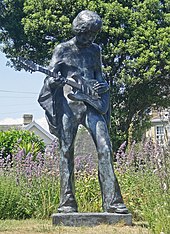Isle of Wight
The island has played an essential part in the defence of the ports of Southampton and Portsmouth and has been near the front line of conflicts through the ages, having faced the Spanish Armada and weathered the Battle of Britain.Being rural for most of its history, its Victorian fashionability and the growing affordability of holidays led to significant urban development during the late 19th and early 20th centuries.However, the two counties continue to share their police force and fire and rescue service, and the island's Anglican churches belong to the Diocese of Portsmouth (originally Winchester).A combined local authority with Portsmouth and Southampton was considered[9] as part of a regional devolution package but was subsequently rejected by the UK government in 2018.These are all variants of the same name, possibly sharing a Celtic origin[11][12] with Welsh gwaith 'work', a cognate of both Latin vectis ("lever," or literally "the act of lifting") and Old English wiht ("weight").The earliest clear evidence of Lower Palaeolithic archaic human occupation on what is now the Isle of Wight is found close to Priory Bay.More than 300 acheulean handaxes have been recovered from the beach and cliff slopes, originating from a sequence of Pleistocene gravels dating approximately to MIS 11-MIS 9 (424,000–374,000 years ago).A Middle Palaeolithic Mousterian flint assemblage, consisting of 50 handaxes and debitage, has been recovered from Great Pan Farm in the Medina Valley near Newport.However, evidence of late Upper Palaeolithic activity has been found at nearby sites on the mainland, notably Hengistbury Head in Dorset, dating to just before the onset of the Holocene and the end of the last glacial period c. 11,700 years ago.A submerged escarpment 11 metres (36 feet) below sea level off Bouldnor Cliff on the island's Solent coastline has yielded an internationally significant mesolithic archaeological site.Highly visible evidence of early Bronze Age activity on the Isle of Wight comes in the form of the barrow monuments present across the island's chalk downland.[30][31] Julius Caesar reported that the Belgae took the Isle of Wight in about 85 BC[32] and recognised the culture of this general region as "Belgic" but made no reference to Vectis.[39] Starting in AD 449, the 5th and 6th centuries saw groups of Germanic-speaking peoples from Northern Europe crossing the English Channel and gradually set about conquering the region.[52] During the English Civil War, King Charles I fled to the Isle of Wight, believing he would receive sympathy from Governor Robert Hammond.[54] In the spring of 1817, the twenty-one year old John Keats spent time in Carisbrooke and Shanklin, where he found inspiration in the countryside and coast, and worked on his long poem Endymion.Subsequently, the island became a fashionable holiday resort for many, including Alfred, Lord Tennyson, Julia Margaret Cameron, and Charles Dickens (who wrote much of David Copperfield there), as well as the French painter Berthe Morisot and members of European royalty.The boom in tourism, spurred by growing wealth and leisure time and by Victoria's presence, led to the significant urban development of the island's coastal resorts.[62][63] On 14 January 1878, Alexander Graham Bell demonstrated an early version of the telephone to the queen,[64] placing calls to Cowes, Southampton, and London.[77] On 26 October 2020, an oil tanker, the Nave Andromeda, suspected to have been hijacked by Nigerian stowaways, was stormed southeast of the island by the Special Boat Service.[83] West Wight is predominantly rural, with dramatic coastlines dominated by the chalk downland ridge, running across the whole island and ending in the Needles stacks.[86] These strata continue west from the island across the Solent into Dorset, forming the basin of Poole Harbour (Tertiary) and the Isle of Purbeck (Cretaceous) respectively.[87] Dinosaur bones and fossilised footprints can be seen in and on the rocks exposed around the island's beaches, especially at Yaverland and Compton Bay, from the strata of the Wessex Formation.The table below shows the regional gross value (in millions of pounds) added by the Isle of Wight economy, at current prices, compiled by the Office for National Statistics.GKN operates what began as the British Hovercraft Corporation, a subsidiary of (and known latterly as) Westland Aircraft, although they have reduced the extent of plant and workforce and sold the main site.[109] In 2005, Northern Petroleum began exploratory drilling for oil at its Sandhills-2 borehole at Porchfield, but ceased operations in October that year after failing to find significant reserves.The 70 miles (113 km) Isle of Wight Coastal Path follows the coastline as far as possible, deviating onto roads where the route along the coast is impassable.[140][141] To promote the island's identity and culture, the High Sheriff, Robin Courage, founded an Isle of Wight Day; the first was held on 24 September 2016.This position led to it hosting three prisons: Albany, Camp Hill and Parkhurst, all located outside Newport near the main road to Cowes.[149] Parkhurst enjoyed notoriety as one of the toughest jails in the United Kingdom, and housed many notable inmates including the Yorkshire Ripper Peter Sutcliffe, New Zealand drug lord Terry Clark and the Kray twins.It was built on the site of an army camp (both Albany and Parkhurst were barracks); there is a small estate of tree-lined roads with the former officers' quarters (now privately owned) to the south and east.


















Isle of Wight (disambiguation)IOW (disambiguation)Ceremonial countySovereign stateUnited KingdomConstituent countryEnglandRegionSouth EastTime zoneJoe RobertsonIsle of Wight EastRichard QuigleyIsle of Wight WestHampshire and Isle of Wight ConstabularyCeremonial countyLord LieutenantHigh Sheriff46th of 48Unitary authorityIsle of Wight CouncilControlNo overall controlNewport90th of 296162nd of 296GSS codeEnglish ChannelHampshireSolentVictorian timesdownlandchineshistoricallyUNESCO Biosphere ReserveSingaporeAlgernon Charles SwinburneAlfred, Lord TennysonQueen VictoriaOsborne HouseEast Cowesflying boatshovercraftspace rocketsIsle of Wight FestivalfossilsSouthamptonPortsmouthSpanish ArmadaBattle of Britainadministrative countyLord Lieutenantpolice forcefire and rescue serviceAnglicanDiocese of PortsmouthWinchestercombined local authoritydevolutionHovertravelSouthseaLymingtonWightlinkRed FunnelDomesday BookOld EnglishHistory of the Isle of WightPleistoceneglacial periodsSolent Riverhand axePaleolithicLower PalaeolithicPriory Bayacheulean handaxesMIS 11Homo heidelbergensisNeanderthalsMiddle PalaeolithicMousterianMIS 3 interstadiallast glacial periodUpper Palaeolithicmodern humanhunter-gatherersHengistbury HeadHoloceneNeolithicMesolithicBouldnor CliffMottistonelong barrowTennyson DownFreshwaterBell Beaker CultureBronze AgeArretonbarrow monumentsBrook.early Bronze AgeBronze Age BritainbronzeFerriby BoatsLate Iron AgeCeltic BritonsDurotrigesBrittonic CelticIron AgeJulius CaesarBelgaeSuetoniusVespasianRoman villasAnglo-SaxonBouldnorGermanicEarly Middle AgesheathenWihtwaraLife of AlfredWest Saxon kingsCerdicCynricGothicBritonsCædwalla


